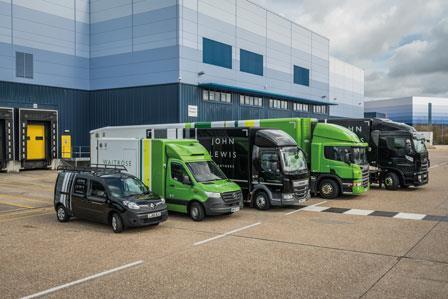
Knowing when, where and how to cut carbon emissions from your fleet isn’t easy. But the John Lewis Partnership is leading the way by gradually switching from biomethane to electric.
It’s interesting that in the same week that MT gets an update from the John Lewis Partnership (JLP) on its decarbonisation plans, a major new survey reveals that many smaller hauliers have put the topic firmly on the back-burner.
The Transporeon report concludes that while major European operators are investing in a low-carbon future, hauliers with less than 20 vehicles see little commercial benefit. In the current climate, cashflow remains their top priority.
That’s not to take anything away from companies with the resources to fully commit to decarbonisation, of course. And as the winner of our Low Carbon Award for 2020, JLP has a persuasive argument. The retailer’s entire heavy truck fleet will be running on biomethane by 2028 and the first of its electric vehicles for urban operation will launch in April.
The overall plan covers 600 heavy trucks, 750 refrigerated trailers, 1,750 home delivery vans and light trucks, and 20 farm vehicles. A rolling replacement programme is now being accelerated and all 600 HGVs will be running on biomethane by 2028.

Justin Laney, pictured, partner and general manager of central transport at JLP, also has a strong message for firms worried by the cost implications of following his lead.
“The risk is if you sit back and don’t get engaged, your competitors will suddenly be operating at much lower costs than you can,” he warns. “If you run a biomethane truck and your competitor is on diesel, then you’re saving £20,000 per truck over what his costs are.
“So pick the right technology and move with it at the right pace. Have confidence it will operate in the real world. Doing nothing is more risky than being engaged, even if you’re not buying trucks just yet.
“Yes, it will cost you more to buy it and think about filling stations. But the more miles you do, the more you save.”
To an extent, Laney’s views are at odds with those of Lee Holmes, transport operations manager with Wren Kitchens, who told MT last month that the zero-carbon argument lacks leadership and is therefore doomed to fail: “You cannot set targets for zero carbon with no strategy of who, how, why and where all these things are going to come together,” he suggested.
Conflicting industry opinion over the issue has become commonplace. Laney agrees that the future appears to be a confusing mix of alternatives – biofuel, gas, battery electric, hydrogen, even electrified roads. There’s no clear winner, no silver bullet, but JLP has done its homework and developed a long-term strategy that will ultimately see its heavy fleet switch from biomethane to electric.
The company is not only using telematics and aerodynamically optimised trailers, but also plans to eliminate fossil fuels from its home delivery fleet using EV manufacturer Arrival’s Generation 2 concept and other vehicles.
“Arrival’s electric vehicle is brilliant,” Laney explains. “You can operate EVs at higher weights than you can diesel vans – you can go to 4.25 tonnes. To get an extra half tonne is a massive advantage in terms of productivity. That drives the business case.”
On the e-highway
Electrification of JLP’s entire fleet should be completed by 2045. This will come in stages – from batteries and range extenders through to full electrification via e-highways and charging facilities.
Leading logistics expert Professor Alan McKinnon told MT recently that the e-highway idea championed by Siemens “at first seemed like science fiction”. But after successful trials in Sweden and Germany, he’s now as keen on the proposal as Laney.
The plan would see trucks driving on the inside lanes of motorways linked via pantographs to overhead catenary cables. The electricity would charge the motor and recharge an on-board battery. The DfT is said to be “open minded” on its potential, despite the £20bn price tag.
But why the need to switch to electric if biomethane is working so well? And why is the e-highway idea of particular interest?
“There’s probably not enough biomethane for everybody,” Laney explains. “You can argue for battery electric, but the battery you’d need would be enormous, so that wouldn’t happen for the long-distance sector. Or you could argue hydrogen, but it’s a very inefficient technology and very expensive. So you arrive at catenary, which on the face of it seems madness because nobody’s going to build it until the trucks are there and nobody’s going to buy the trucks until the catenary’s there.
“But £20bn is less than a nuclear power station. It’s a fraction of HS2. There are a lot of infrastructure companies and investors interested in it.”
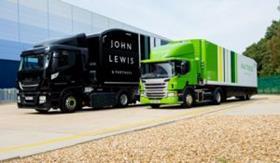
The other problem with biomethane, Laney says, is that it only provides an 80% reduction in carbon emissions. JLP is determined to get that to 100% with electricity, so is supporting a £100m e-highway trial from Immingham Docks to Doncaster. This will assess where each pentagraph and sub-station should be placed, the location of power sources, and other practicalities.
But ultimately any decision will be driven by a business case, the task being to make the best environmental solution the cheapest.
“There are two main competing schools of thought,” Laney says. “There’s a hydrogen lobby and a catenary lobby. I’m very confident that catenary would come out a lot cheaper than hydrogen – and be more doable because the challenge of generating that amount of hydrogen and distributing it around the country is colossal. It’s got to be a viable, robust and reliable system. You need managed risk and assurance over the results of trials.”
Laney is also aware of the need to convince small- to medium-sized firms of the benefits: “The larger operators have the luxury of a fleet engineer and will really get engaged in it,” he says. “So it’s up to them to demonstrate it and take some of the pain in the trials.
“It’s no good if you need a massive expensive biomethane plant on your own premises. There’s got to be a public access network of filling stations. There’s got to be a second-hand market as well. It means the people who buy used trucks have access to the technology.
“You can’t do something space age – it has to be something that can be used very widely long term by everyone.”
But why isn’t simply switching to Euro-6 diesel enough to keep the government happy?
“For air quality – NOx – Euro-6 is fine,” Laney agrees. “Policy makers don’t understand that. They want to ban diesel from city centres, but it’s not great on CO2 and that’s the problem – you’re tackling air quality, but not global warming and climate change.”
Picking a winner
The dilemma now facing truck makers, it seems, is which technology to back. Is a battery vehicle with a diesel range extender allowed for example?
“It’s a tricky one,” Laney admits. “Also important is that fleets like us involved in groceries, dried goods and parcels all return to base. You can have a filling station there, or one near it, and you have plenty of space in the chassis for gas tanks. But for an operator with a 6x2 three-axle truck who hasn’t got the space and is tramping around the country, it’s much more challenging. You’ve got to be sure you can fill up when you need to.
“And do you have a relatively short range of maybe 300 miles on CNG, or do you go ONG which is more difficult to manage?”
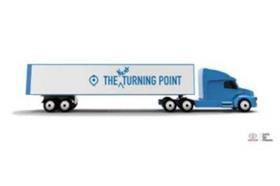
News last month that truck manufacturers are investing in hydrogen fuel-cell technology to avoid paying hefty emissions penalties is another interesting development. Might that have an impact on JLP’s strategy?
“I’m not convinced by hydrogen,” Laney says. “The problem is it takes a lot of energy to make it in the first place and then a lot more to compress it to the levels people are talking about. And the fuel cells aren’t that efficient. You put 100 units of power in and get 20 out. And the cost of the energy is higher. So it doesn’t compete very well with catenary or biomethane.”
He agrees that even some of the big operators are adopting a ‘wait and see’ approach.“Some are interested in biomethane, but nobody’s offering a hydrogen truck yet,” he says. “I don’t think anyone is seriously considering that. I always advise people to borrow a trial vehicle from us and see what they think. You need to be a smart follower. Don’t ignore it and hope it goes away.
“There’s also a lot of co-operation between companies on this. And there are some good bodies like the Low Carbon Vehicle Partnership and the Low Carbon Working Group who will give good advice.
“This is genuinely a time of disruption and change,” Laney concludes. “There were people who only understood steam traction engines and didn’t think petrol and diesel would work. When the technology is established and is better and quicker, so you get more productivity and the fuel is cheaper, the whole market will move.”
The deadline to enter the 2021 MT Awards is 9 April. Go to the website for full details on how to enter.








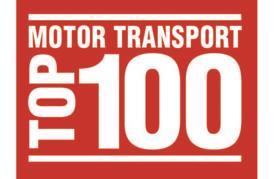
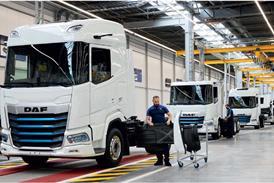

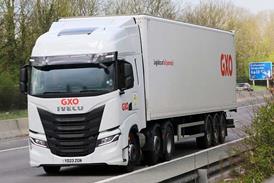

![Mercedes-Benz_eActros_600_(1)[1]](https://d2cohhpa0jt4tw.cloudfront.net/Pictures/274x183/8/2/0/17820_mercedesbenz_eactros_600_11_978080.jpg)